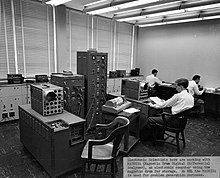Differential analyzer

Scientists at the US Navy work (Engl. To MADDIDA machines magnetic drum digital differential analyzer )
The differential analyzer ( English differential analyzer ) was an electro-mechanical analog computer , the number of differential equations could handle simultaneously. The output took place by means of automatically printed diagrams. It was developed between 1928 and 1932 at the Massachusetts Institute of Technology (MIT) under the direction of Vannevar Bush and HL Hazen.
So-called digital differential analyzers (DDAs) were later developed, which temporarily stored the numbers in registers . They represent a transition step between analog calculating machines and digital computers. In analogy to this, certain simple algorithms for rasterizing lines are also called DDA in computer graphics .
See also
literature
- RE Sprague: Technical Developments: Fundamental Concepts of the Digital Differential Analyzer Method of Computation. In: Mathematical Tables and Other Aids to Computation 6, No. 37, ISSN 0891-6837 , 1952, pp. 41-49.
- Andreas Brennecke: Physical analogies and number calculating machines - From mechanical calculating devices to integration systems and program-controlled machines. Proceedings of the 1st symposium on the “Development of Computing Technology” from September 15 to 17, 2000 at the Institute for Mathematics and Computer Science at the Ernst-Moritz-Arndt University of Greifswald , pp. 89–111 ( online ).
- Patent US4106100 : Digital differential analyzer. Published August 8, 1978 , Applicants: Hitachi , Inventors: Kunihiro Okada, Yoshiharu Itatsuda, Takeyuki Endoh, Shigeru Yabuuchi, Norio Yokozawa.
Web links
- DDA on FPGA - emulation of a DDA machine on modern computers
- The differential analyzer in the film at Starring the Computer
- Information page about the Differential Analyzer